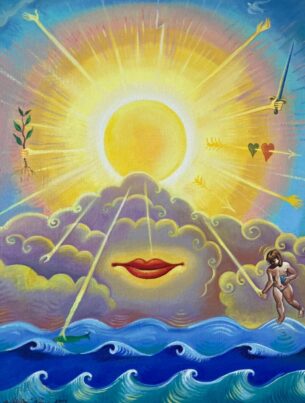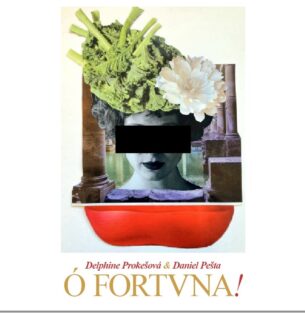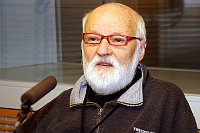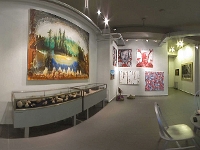Sparking discussion one of Art in Box’s missions, says gallery owner Nadia Rovderová
18-04-2016 13:56 | Ian Willoughby
In over five years of existence, the Art in Box gallery in downtown Prague has put on exhibitions by the great exile photographer Jan Lukas, filmmaking legend Jan Švankmajer and scores of other noteworthy names in various genres. The small gallery is run by the Slovak-born curator, artist and journalist Nadia Rovderová.. When we met recently at Art in Box, I asked Rovderová what had first brought her to the Czech capital.
“The revolution was happening mainly in Prague so after taking part in some student revolutionary activities I decided that I wanted to see it in Prague.
“My girlfriend and I hitchhiked to Prague from Bratislava. We got here in the beginning of December. So that’s how it started. And I stayed!”
What are your strongest memories of that period of the revolution?
“I don’t think something so strong will happen to me ever. It was such a powerful, fantastic time full of energy, full of hope, full of ideas that might change the future.
“I’m so glad that I was already 18 and could be here. Because if I had been 17, my parents wouldn’t have let me go.
“But this was the best time to grow up, to be an adult and to take part in all of that fantastic atmosphere that was in Prague at that time.”
When did your interest in photography first begin?
“Actually I grew up in a family where my father was an amateur photographer.
“He was doing his black-and-white photographs in our bathroom and I was watching how he did it and was very interested.
“I started to do it as well, so when I was 15, 16, 17, I was already taking a lot of photographs and developing my own pictures. I took part in student contests. This is how it started.
“Then in Prague, during the revolution, I met my first boyfriend. He came from a famous family of photographers.
“Actually his great-great-grandfather was one of the first Czech photographers: Jaroslav Feyfar.
“His grandfather Zdenko Feyfar was a good friend of Sudek and all these famous people here.
“We were living in his studio where he had his enlarger and all his equipment. We were surrounded by fantastic photos. We were helping him – when he was photographing Prague Castle, we assisted him.
Art in Box gallery, photo: archive of Art in Box gallery“
So I fell into the photographic waters in Prague and I loved it.”
You started Art in Box five or six years ago. What did you do between the time you’re talking about and the beginning of the gallery?
“Actually, I started as a journalist, because the university where I studied was the Philosophical Faculty, Department of Journalism.
“I was always interviewing artists. I was writing articles about art. I was cooperating for eight years on a big project, a book on Andy Warhol, which was recently published by the publishers Arbor Vitae. So I was already around art.
“And in 2002 I started to be involved with M.E.C.C.A., the Middle European Colony of Contemporary Art, in Terezín. We were doing exhibitions and workshops and I was running the photo centre there.
“In 2003 I started to run a gallery of Czech sculpture, ArtPro, here in Prague. I ran that for four years.
“Then I became a mother and was taking care of two small children. After that I could decide whether to go on with the gallery where I was employed, or whether to start my own project.
“I decided for the second option, which was quite difficult but more joyful for me, let’s say.”
Tell us about the beginnings of Art in Box – what were the big challenges in the early days?
“To survive. Because having a private gallery in the Czech Republic is really not an easy thing.
“We’re actually struggling every day and every month to be here and to do what we want to do, to have money to do what we do.”
What’s your system here – do you also sell photography?
“Of course. If we didn’t, we wouldn’t be able to survive financially. So we need some income from selling photography or other art works.
“Also we try to get support for some exhibition projects from some institutions.”
I notice from your website that you have worked a few times with Jan Švankmajer. How did that come about?
Jan Švankmajer, photo: Šárka Ševčíková
“Yes, I am so glad to have the opportunity to organise exhibitions with him.
“The gallery actually started in October 2010 with our first exhibition, which was an exhibition of work by Jan Švankmajer connected to his movie Survive Your Life.
“He showed here collages made from photographs which were animated in the movie. So this was our beginning
“Last October we celebrated five years, so we organised a small exhibition of his recent work here in the small hall and it was a big success.
“I’m so glad I have this opportunity to work with this great personality of Czech art and Czech film.”
What’s he like at the personal level? To me he’s an almost mythical figure who lives up at the Castle in his little house, if he still does. What’s he really like?
“He’s fantastic. He’s very modest and very smart. For me he’s like a personality from a fairytale. He’s really got a kind of aura around him.
“I like to observe how people react to him. Several times here I’ve witnessed a scene here when there were visitors at the gallery – a Japanese woman, a man from France – and when they saw him live they almost collapsed, because they couldn’t believe he was real!
“He’s really like from a fantasy world. But he’s a real person and he’s a very, very nice man.”
Otherwise what have been some of the outstanding or particularly noteworthy exhibitions you’ve had here over the years?
“Oh, there have been tens and tens of exhibitions… A very big success was our exhibition of Jan Lukas last year.
“It was the anniversary of his birth and we were actually the only gallery to show his work here in Prague. He had several exhibitions in České Budějovice, where he was born.
“It was incredible to see the amount of people who wanted to see his work. It was for me a pleasure to see that my work really has some meaning.
Photo: archive of Art in Box gallery
“When the exhibition was almost finished we got some financial support from the Czech Ministry of Culture and we were able to print a catalogue.
“So I’m very glad that we have some result of this exhibition which will be lasting. Because exhibitions finish and if you don’t have a catalogue, nothing remains.
“It’s been great to publish the catalogue, which has had great success, just like the exhibition had.
“Then we had several themed exhibitions, which is another direction that I’m trying to go in.
“Some exhibitions were reacting to topics that I thought were important to talk about.
“For instance we had the group exhibition Peace Please, where 40 or 50 artists were showing their work on the somewhat shaky peace in the world.
“In the same way we reacted to the presidential elections. I organised the exhibition Who lies, steals? [From a Czech phrase that goes, Whoever lies can also steal].
“It was an exhibition in which we were asking about the moral aspects of politics and about what politicians are doing.
“We were trying to show some aspects that we think society should be talking about and discussing.”
So do you feel that to some degree the gallery also has a political mission?
“Sure. These were two examples but we also had an exhibition which was about the Holocaust, an exhibition that focused on femininity and an exhibition under the title The Art of Giving Birth, about women and their mission to become a mother and how society deals with that fact.
“Usually these difficult themes cause people not to come to our gallery. People don’t want to see birth, they don’t want to see the Holocaust.
“Peace Please was also a less visited exhibition than the others, because people don’t like to see the dark sides of life. But I think it’s important to show them and to talk about them.”
Art in Box gallery, photo: archive of Art in Box gallery
Generally speaking do you have trouble attracting people to Art in Box? It’s in a building, down a corridor, down some steps and it’s kind of a small space.
“I was a little bit worried about it in the beginning. But actually we realised that once people learn where we are they know how to get here and they come back.
“It’s not that big a problem as I thought it would be in the beginning. Of course if we were on the street, visible from the street, it would be easier. But I don’t think it’s that big a problem as it might seem.”







